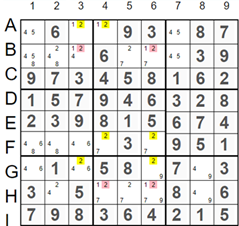
The picture on the left shows the Swordfish pattern. It appears in cells located at the intersections of rows A, F, and G with columns 3, 4, and 6. In this example, the hint
'2' marked in yellow, appears twice in each of the selected rows and columns. Rows A, F, and G don’t have the hint 2 in any cell except within the Swordfish pattern formation. This pattern is called a Swordfish in Rows. Since the Sudoku solution requires that each row should have one cell with a value of 2, three of the nine Swordfish cells should have a value of 2. This means that each Swordfish column will have one cell with a value of 2. Therefore, we can remove hint 2 from columns 3, 4, and 6 outside of the nine Swordfish cells. In our example, we can remove hint
'2' from cells B3, H3, B6, and H6, which are marked in red.